FPC产品讲义及流程简介
- 格式:ppt
- 大小:2.79 MB
- 文档页数:48
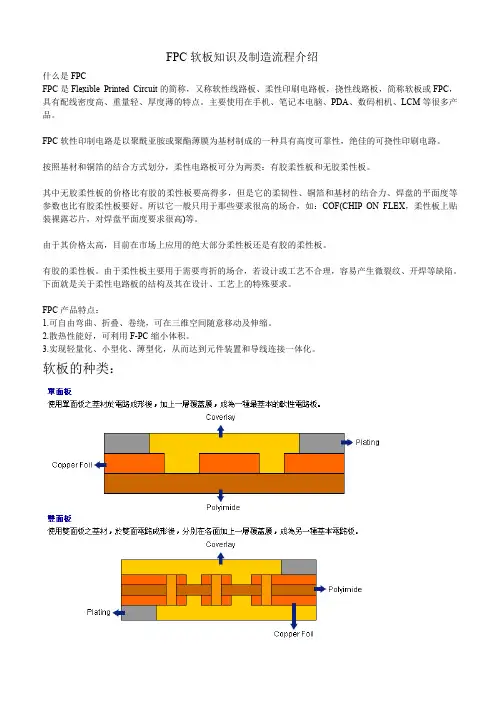
FPC软板知识及制造流程介绍
什么是FPC
FPC是Flexible Printed Circuit的简称,又称软性线路板、柔性印刷电路板,挠性线路板,简称软板或FPC,具有配线密度高、重量轻、厚度薄的特点。
主要使用在手机、笔记本电脑、PDA、数码相机、LCM等很多产品。
FPC软性印制电路是以聚酰亚胺或聚酯薄膜为基材制成的一种具有高度可靠性,绝佳的可挠性印刷电路。
按照基材和铜箔的结合方式划分,柔性电路板可分为两类:有胶柔性板和无胶柔性板。
其中无胶柔性板的价格比有胶的柔性板要高得多,但是它的柔韧性、铜箔和基材的结合力、焊盘的平面度等参数也比有胶柔性板要好。
所以它一般只用于那些要求很高的场合,如:COF(CHIP ON FLEX,柔性板上贴装裸露芯片,对焊盘平面度要求很高)等。
由于其价格太高,目前在市场上应用的绝大部分柔性板还是有胶的柔性板。
有胶的柔性板。
由于柔性板主要用于需要弯折的场合,若设计或工艺不合理,容易产生微裂纹、开焊等缺陷。
下面就是关于柔性电路板的结构及其在设计、工艺上的特殊要求。
FPC产品特点:
1.可自由弯曲、折叠、卷绕,可在三维空间随意移动及伸缩。
2.散热性能好,可利用F-PC缩小体积。
3.实现轻量化、小型化、薄型化,从而达到元件装置和导线连接一体化。
软板的种类:
软板制造流程:
详细制造流程:
软板的应用:。
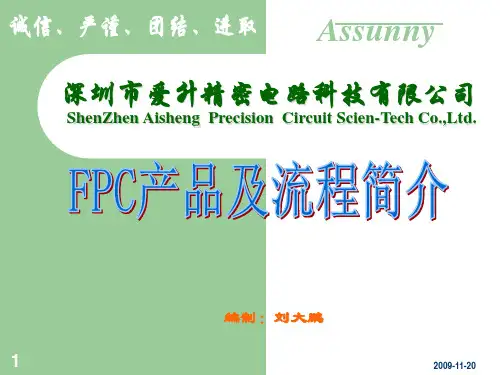
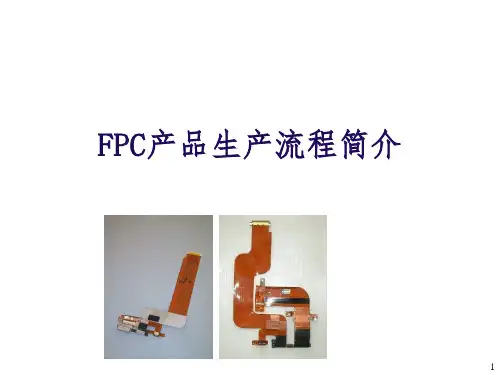
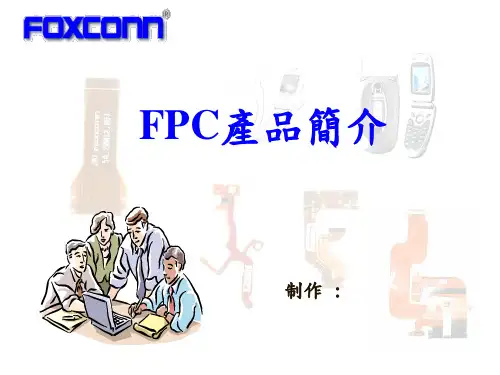
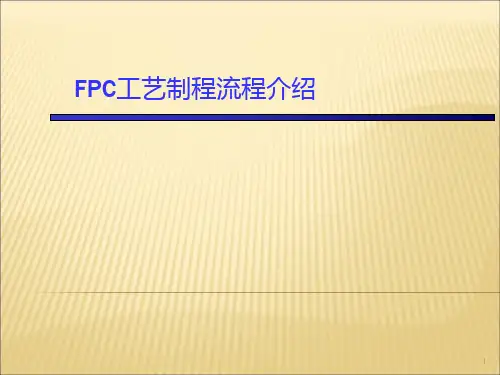
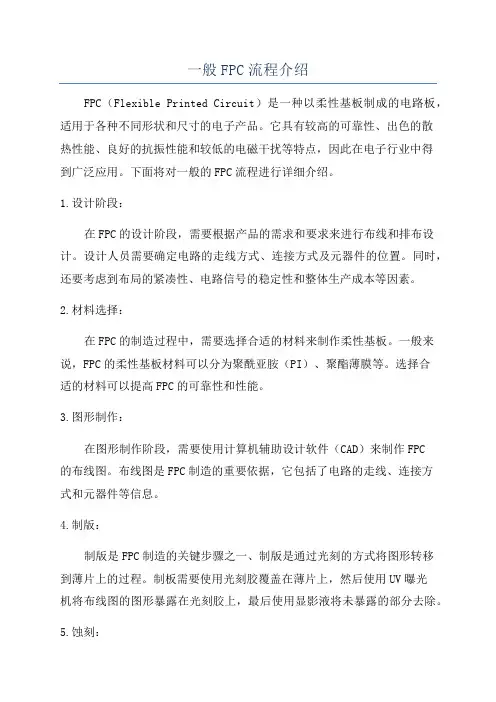
一般FPC流程介绍FPC(Flexible Printed Circuit)是一种以柔性基板制成的电路板,适用于各种不同形状和尺寸的电子产品。
它具有较高的可靠性、出色的散热性能、良好的抗振性能和较低的电磁干扰等特点,因此在电子行业中得到广泛应用。
下面将对一般的FPC流程进行详细介绍。
1.设计阶段:在FPC的设计阶段,需要根据产品的需求和要求来进行布线和排布设计。
设计人员需要确定电路的走线方式、连接方式及元器件的位置。
同时,还要考虑到布局的紧凑性、电路信号的稳定性和整体生产成本等因素。
2.材料选择:在FPC的制造过程中,需要选择合适的材料来制作柔性基板。
一般来说,FPC的柔性基板材料可以分为聚酰亚胺(PI)、聚酯薄膜等。
选择合适的材料可以提高FPC的可靠性和性能。
3.图形制作:在图形制作阶段,需要使用计算机辅助设计软件(CAD)来制作FPC的布线图。
布线图是FPC制造的重要依据,它包括了电路的走线、连接方式和元器件等信息。
4.制版:制版是FPC制造的关键步骤之一、制版是通过光刻的方式将图形转移到薄片上的过程。
制板需要使用光刻胶覆盖在薄片上,然后使用UV曝光机将布线图的图形暴露在光刻胶上,最后使用显影液将未暴露的部分去除。
5.蚀刻:在蚀刻过程中,需要将光刻胶暴露出的区域进行蚀刻,以保留需要的电路。
蚀刻可以使用化学蚀刻或机械蚀刻的方式进行。
化学蚀刻是在蚀刻液中进行,而机械蚀刻则是通过机械刮擦来去除暴露的部分。
6.印刷:在印刷过程中,需要使用印刷机将铜箔层印刷在制好的基板上。
印刷可以选择用胶印的方式或者丝网印刷的方式进行。
印刷完之后,需要使用热压设备将铜箔固定在基板上。
7.前后钼层:钼层的添加可以提高FPC的强度和导电性能。
在前后钼层的制作中,需要使用相应的化学方法将钼涂覆在FPC的表面,并通过热压的方式固定。
8.表面处理:表面处理是为了提高FPC的可焊性和耐腐蚀性,在FPC上增加一层金属,一般来说是电镀。
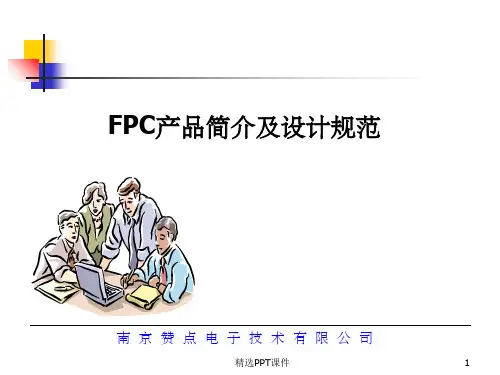
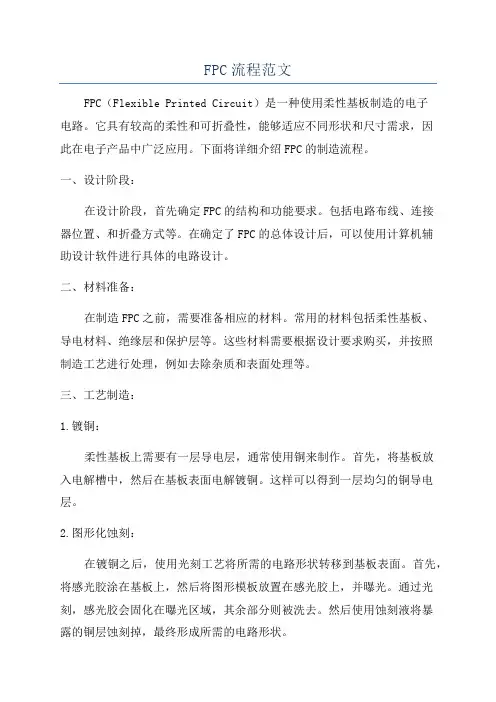
FPC流程范文FPC(Flexible Printed Circuit)是一种使用柔性基板制造的电子电路。
它具有较高的柔性和可折叠性,能够适应不同形状和尺寸需求,因此在电子产品中广泛应用。
下面将详细介绍FPC的制造流程。
一、设计阶段:在设计阶段,首先确定FPC的结构和功能要求。
包括电路布线、连接器位置、和折叠方式等。
在确定了FPC的总体设计后,可以使用计算机辅助设计软件进行具体的电路设计。
二、材料准备:在制造FPC之前,需要准备相应的材料。
常用的材料包括柔性基板、导电材料、绝缘层和保护层等。
这些材料需要根据设计要求购买,并按照制造工艺进行处理,例如去除杂质和表面处理等。
三、工艺制造:1.镀铜:柔性基板上需要有一层导电层,通常使用铜来制作。
首先,将基板放入电解槽中,然后在基板表面电解镀铜。
这样可以得到一层均匀的铜导电层。
2.图形化蚀刻:在镀铜之后,使用光刻工艺将所需的电路形状转移到基板表面。
首先,将感光胶涂在基板上,然后将图形模板放置在感光胶上,并曝光。
通过光刻,感光胶会固化在曝光区域,其余部分则被洗去。
然后使用蚀刻液将暴露的铜层蚀刻掉,最终形成所需的电路形状。
3.涂覆保护层:在形成电路后,需要对其进行保护,以防止受到外界环境的侵蚀。
通常使用覆盖一层保护层来实现。
保护层是由绝缘材料制成的,可以通过涂覆的方式施加到基板上。
涂覆保护层后,可以使用烘焙炉将其固化。
4.连接器安装:在保护层固化后,需要将连接器安装到FPC上。
连接器可以根据具体需求进行选型,并通过焊接或压合等方式固定在FPC上。
连接器的安装位置需要根据设计要求和电路布线来确定。
5.检验和测试:在制造完成后,需要进行检验和测试以确保FPC的质量符合要求。
检验可以包括外观检查、电导率测试、弯曲和折叠测试等。
通过这些测试,可以评估FPC的性能和可靠性。
6.最终组装:在通过检验和测试后,FPC可以用于最终产品的组装。
通常是将FPC 与其他电子元件进行连接,然后组装到产品的相应位置。
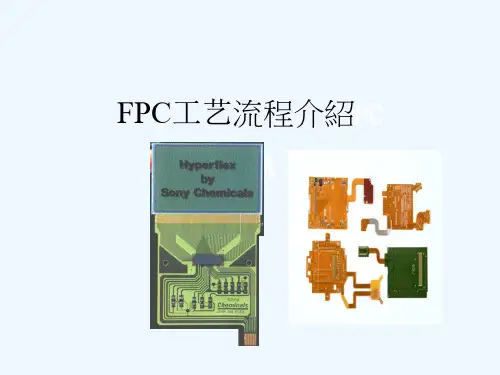

fpc基本知识及流程介绍英文回答:Introduction to FPC:FPC, which stands for Free Pascal Compiler, is a popular open-source compiler for the Pascal programming language. It is a cross-platform compiler that supports a wide range of operating systems, including Windows, macOS, Linux, and more. FPC is known for its compatibility with the Delphi programming language, allowing developers to easily port their Delphi projects to other platforms.FPC Workflow:1. Installation: The first step in using FPC is to download and install it on your computer. FPC can be downloaded from the official website and comes with an installer that guides you through the installation process.2. Writing Code: Once FPC is installed, you can start writing Pascal code using any text editor or integrated development environment (IDE) of your choice. FPC supports both console-based and graphical user interface (GUI) applications.3. Compiling: After writing the code, you need to compile it using the FPC compiler. The compiler takes the Pascal source code as input and generates executable files that can be run on the target platform. The compilation process checks for syntax errors and performs necessary optimizations.4. Running the Program: Once the code is successfully compiled, you can run the resulting executable file on your computer. FPC provides a command-line interface to execute the program. Alternatively, you can also run the program from within an IDE that supports FPC.5. Debugging: If there are any errors or issues in your program, FPC provides debugging tools to help you identify and fix them. You can set breakpoints, inspect variables,and step through the code to understand its execution flow.6. Deployment: After thorough testing and debugging, you can deploy your Pascal application to the target platform. FPC allows you to create standalone executables or libraries that can be distributed to other users.Conclusion:FPC is a versatile compiler for the Pascal programming language, offering cross-platform support and compatibility with Delphi. Its workflow involves installation, code writing, compilation, program execution, debugging, and deployment. With FPC, developers can create efficient and portable Pascal applications for various operating systems.中文回答:FPC基本知识及流程介绍:FPC,全称为Free Pascal Compiler,是一款流行的开源Pascal编译器。

fpc基本知识及流程介绍English Answer:Introduction.Formal Process Chain (FPC) is a methodology fordefining and managing the engineering processes within an organization. It provides a structured approach to identifying, documenting, and controlling the processesthat are essential to delivering products and services. FPC is based on the ISO 9001 quality management system, and it can be used to support compliance with other regulatory standards, such as ISO 14001 (environmental management) and ISO 27001 (information security).FPC Methodology.The FPC methodology consists of four main steps:1. Process Identification: Identify all of theprocesses that are involved in delivering products and services.2. Process Definition: Develop detailed descriptions of each process, including the inputs, outputs, and activities involved.3. Process Control: Establish mechanisms to control and monitor each process, including the use of standard operating procedures (SOPs) and key performance indicators (KPIs).4. Process Improvement: Continually improve processes by identifying and eliminating inefficiencies, and by implementing new technologies and methodologies.Benefits of FPC.Implementing FPC can provide numerous benefits to an organization, including:Improved quality: FPC helps to ensure that productsand services meet customer requirements by identifying and controlling the processes that affect quality.Increased efficiency: FPC helps to streamline processes and eliminate waste, which can lead to increased productivity and cost savings.Improved compliance: FPC provides a framework for compliance with regulatory standards, which can help to reduce the risk of fines and penalties.Increased customer satisfaction: FPC helps to ensure that products and services meet customer needs, which can lead to increased customer satisfaction and loyalty.FPC Implementation.Implementing FPC can be a complex and time-consuming process. However, it is important to note that FPC is not a one-size-fits-all solution. The best approach to FPC implementation will vary depending on the size and complexity of the organization.There are a number of resources available to help organizations with FPC implementation, including:Consultants: There are many consultants who specialize in FPC implementation. Consultants can help organizations to identify and define their processes, develop SOPs, and establish KPIs.Software: There are a number of software programs that can help organizations to manage and control their processes. These programs can help organizations to track process performance, identify bottlenecks, and implement corrective actions.Training: There are a number of training programs available to help organizations learn about FPC. Training can help organizations to understand the benefits of FPC, and how to implement FPC in their own organization.Conclusion.FPC is a valuable tool for organizations that are looking to improve their quality, efficiency, and compliance. By implementing FPC, organizations can gain a competitive advantage and deliver better products and services to their customers.Chinese Answer:Formal Process Chain (FPC)。